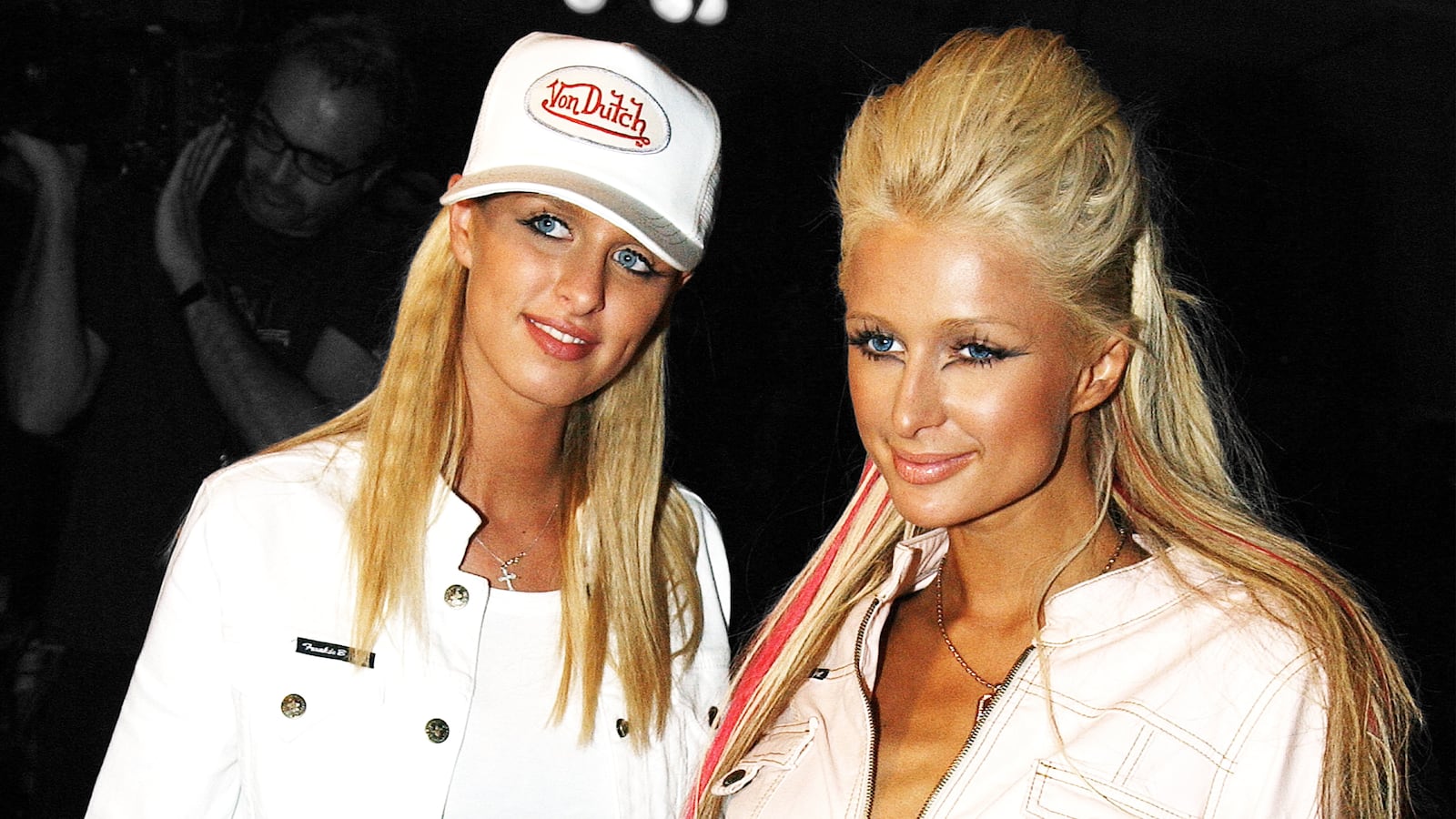In the aughts, it was impossible to miss the sensation that was Von Dutch.
What started out as a small counter-culture brand intent on creating high-quality denim suddenly exploded onto the scene.
The Venice Beach-based label was known for its iconic trucker hats stamped with the scrawly signature logo, popularized by the likes of Ashton Kutcher, Jay Z, Madonna, Britney Spears, and of course: it girls of the era Paris Hilton and Nicole Richie, who almost exclusively wore Von Dutch’s camouflage pants and flame caps when they swapped glittery Los Angeles for The Simple Life.
Then all of a sudden, Von Dutch vanished. It became an odd relic of pop-culture history.
Now, Hulu’s new three-part docuseries, The Curse of Von Dutch: A Brand to Die For, premiering Nov. 18, sheds light on the little-known behind-the-scenes turmoil at the infamous label, revealing vicious infighting, dirty legal tricks, revenge, and even menacing threats from the family of Pablo Escobar. It all crescendoed in homicide and the fall of a once up-and-coming fashion company.
While the Von Dutch name is mostly synonymous with Y2K fashion, not many are familiar with the brand’s namesake: the Los Angeles artist and motorcycle mechanic Kenny Howard.
A legendary figure of hot-rod culture in the 1950s and ’60s, Howard was a screwball, an alcoholic, and an overall jackass, but is credited as being the father of modern pinstriping on automobiles.
Howard had a keen eye and artistic flair, but unlike other artists, he was blasé when it came to his work and his art pieces. “Use any of my stuff you want to,” Howard’s manifesto is quoted in the docuseries. “Nothing is original. Everything is in the subconscious, we just ‘tap’ it sometimes and think we have originated something. Genes make us more or less interested in certain things, but nothing is truly original! Copyright and patents are mostly an ego trip.”
But ironically, Von Dutch was spun into a mainstream, flashy clothing company that ultimately unraveled following a pissing match between a squirrelly cast of characters who each believed the brand belonged to them.
“When I think about the curse, it’s this idea that it was never anyone’s in the first place,” director Andrew Renzi explains to The Daily Beast. “You kind of get this Raiders of the Lost Ark monopoly thing, where this logo that was nobody’s except for this guy who passed away and never would have wanted this to have happened in the first place, is attracting all these people. I found that so fascinating because it’s kind of true. It just laid wreckage and it’s because everybody got so obsessed with the idea that it was theirs and that they deserved it and that they should have it.”
At the heart of the battle were three men: Ed Boswell, Mike Cassel, and Robert “Bobby” Vaughn.
Boswell was the first to lay claim to the name. After Howard died in 1992 at the age of 63 due to liver problems from his excessive drinking, his daughters sold the rights to his namesake to Boswell, a hot-rod culture fan and art dealer who began selling patches of the Von Dutch signature and his iconic flying-eyeball graphic.
At a 1996 trade show, Boswell met Cassel. who had already started up the popular skateboard/surfer/gangster clothing brand Bronze Age Venice Underground but had lost the company after a bad business deal and was looking for his next idea.
Cassel had a reputation for being a ruthless wildcard, largely due to his past as a drug kingpin who had ties to Colombian drug lord Pablo Escobar’s associates, helping push cocaine up the West Coast. After a short stint in prison for possession of drugs, Cassel wanted to finally go legit.

Paris Hilton in The Curse of Von Dutch: A Brand to Die For
HuluArmed with a knack for spinning gold from dust, Cassel believed he finally found something in Von Dutch. But Cassel had a “strange Midas touch,” as one former friend described it. Whatever Cassel touched might have turned to gold, but two seconds later, it would “turn to shit.”
Vaughn, the youngest of the three men, came into the picture when Cassel was still running Bronze Age, which the film claims Cassel largely used to launder his drug money. A fellow outcast, Vaughn was also looking to turn his life around after getting mixed up in a shooting while in high school.
Boswell, Cassel, and Vaughn launched Von Dutch clothing as a team, having a vision of creating the next iconic American denim line—the next Wrangler or Levi’s. But it didn’t take long for the infighting to begin, with Cassel constantly butting heads with Boswell and eventually screwing him out of the company.
From there, everything began to spiral out of control. In dire need of financing, Cassel turned to Danish investor Tonny Sorensen, a wealthy ex-taekwondo champion who came to Los Angeles to try his hand at acting.
Sorensen became CEO by 2000, pumping money into the company and implementing some much-needed structure, bringing in his own people to head the sales and marketing departments.
The move made Vaughn feel sidelined and that his efforts to help get Von Dutch some traction with guerilla-marketing tactics, including getting Tommy Lee and a handful of girls in his mansion into the gear for an episode of MTV’s Cribs, were being ignored.
He was pushed further and further away from Von Dutch, leading him to reconnect with Mark Rivas, a friend from high school that Vaughn had helped escape across the Mexico border after a fatal shooting. Eventually, Sorensen viewed Vaughn as more of a headache than an asset, and in a sly legal maneuver, bought out Vaughn’s stake in the company and fired him.
Booted from a brand he helped build, Vaughn quickly spiraled downward—pulled deeper in the gangster world that Rivas runs in, becoming focused on finding a way back into Von Dutch, and carrying a festering grudge against Sorensen and Cassel, who he felt left him in the lurch.
Meanwhile, Cassel was butting heads with Sorensen. He had been content handing over the business dealings to the Dane, which freed him to focus on designing. But when Sorensen brought on French fashion designer Christian Audigier to create a women’s line, Cassel felt ostracized, believing that Audigier was not only stepping on his toes but also drastically departing from the vision that Von Dutch was founded upon.
So, Sorensen offered him a deal: Cassel could either pony up $2 million within two weeks to buy the company back or he’d have to walk away. Unable to even figure out where he could scrape together that amount of cash, Cassel ended up being ousted from his own company.
Amid the infighting, backstabbing, and Cassel and Vaughn’s departures, Von Dutch’s popularity skyrocketed. Sales were doubling month after month due to the frenzy over the trucker hats.
While Sorensen and Audigier were taking private jets and rubbing shoulders with celebrities who would stop by the store and pick up bags of free merchandise, Cassel and Vaughn were out of the picture.
“It just really did feel like the perfect example of how the cards were stacked against somebody like Mike,” Renzi explains. “That Mike just was not ever meant to succeed in this world and it’s sad.”
From there, it’s a wild ride trying to get to the bottom of what exactly went wrong and who did who dirty, with each of the men offering their own version of events.
Cassel is cagey, never wanting to admit that he might have sicced Pablo Escobar’s son on Sorensen, who was accosted in his office and pointedly told to leave the company for $500,000 cash at a time when Von Dutch was doing $400 million in annual sales.
Vaughn dodges questions about being mixed up with the fatal shooting in high school and accuses Cassel of calling the cops on him when he tried to intimidate Cassel into getting his portion of the company back.
“My life has been insane, kind of Forrest Gump on crack,” Vaughn says in the docuseries, as he explains how he ended up going on trial for the first-degree murder of Rivas, who he shot and killed in Feb. 2005 after a drunken fight where Rivas slashed his neck with a broken bottle.
(A jury acquitted Vaughn after ruling Rivas’ death was justifiable homicide.)
Boswell is depicted as bitter and with barely a penny to show for his work, watching from afar as Von Dutch transformed into a monster brand that was the polar opposite of what Howard would ever want to be associated with.
And Sorensen can’t see beyond Von Dutch as a business, something he could easily walk away from when it became too complicated or when it ceased to benefit him. Meanwhile, Vaughn and Cassel saw it as their chance to escape a life they were desperately trying to leave behind—a secure and legitimate building block that would pave the way toward a better future for their families.

For Renzi, the story of Von Dutch is not so much about pinning down who is the resident villain but more allowing each man to air their grievances and tell their version of events.
“At first it was frustrating,” Renzi admits of trying to pin down an answer, but he eventually saw it as an opportunity to hear everyone out—a true feat given that no one was originally on board.
“Usually, when you get these stories, you do have a perspective that guides you from point A to point B,” he says. “One of the things I love so much about this is that I never came out of it saying, here’s the bad guy, here’s the good guy; here’s the person that was lying, here’s the person that was telling the truth. Everybody has a valid perspective in this story. They all have a reason to be telling their story.”
“It’s heartbreaking to see what happened with Mike and what happened with Bobby,” he adds. “At the end of the day, these two young people of color were doing something great, despite all of the things that were stacked against them. They were never really welcomed in that business, and they tried their best, and unfortunately, it really kind of spit them out in a lot of ways, which is so sad.”
As for Von Dutch the brand, it transmogrified into a fad, as the logo was slapped onto purses and dog clothes, instead of becoming a high-quality legacy American brand, all because of greed, ego, and misaligned visions.
Or it could be because of Howard’s Von Dutch curse—a clear warning to not claim something that was never truly yours to begin with.







